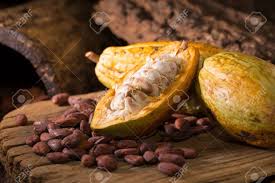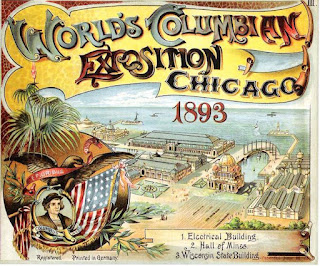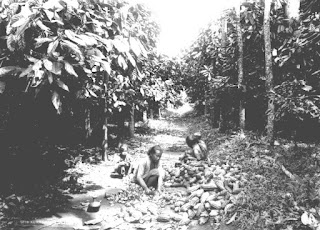CACAO/CHOCOLATE ORIGINS
Mesoamerican by origin and mystical by reputation, cacao—the raw material that produces chocolate and cocoa—comes from the fruit of finicky little trees with shallow roots that, like prima donnas, only grow within twenty degrees north and south of the equator and demand warmth, humidity, and shade. Only three out of a thousand of their flowers, pollinated by small flies, will yield pods containing thirty to forty seeds. No one really knows how or why pre-classic period Olmecs decided to crack open, ferment, roast, winnow, then ground and blend the bitter raw seeds that exact the cacao delicacy that became chocolate. Evidence indicates that the invention of chocolate appeared to have been a “happy accident” of a Olmec brewing process dating as early as 1900 BCE, a method that spread and became a central feature in subsequent Mesoamerica cultures. While too finicky to cultivate to act as a dietary staple like maize, the religious belief system of the Maya civilization (250–900 CE) deified cacao and chocolate, promoting the mysticism that led 18th century botanist Carl Linnaeus to name the tree Theobroma cacao: theo for “gods” and broma for “fruit.” Sacred association with the gods gave cacao and chocolate the treasured, mystic status that insured its social destiny as a rare luxury and precious commodity.
Sacred associations placed cacao as a primordial plant connected to the beginning of life and the gods. The Popol Vuh, the Maya book of creation, mentions cacao as one of the foods the gods used to create humankind. Clay figurines from late classic Mesoamerica connect chocolate with fertility by depicting goddesses with cacao pods growing from their bellies. Archaeologists also uncovered evidence that the Maya considered the cacao plant a conduit between the human and sacred realms, the mortal to the divine. The Maya deemed the cacao seed sacred and the tree taboo, placing the cacao tree in the pantheon of sacred trees as the cosmic marker to the entrance to the afterworld and rebirth. Vessels of chocolate were included in burial tombs in preparation for internment as a source of sacred nourishment for the deceased and for payment to the gods on their way to the afterworld and rebirth.
Cacao’s glorified, mystic reputation elevated its role in society to social currency. Archaeological evidence and cryptographic translations of symbols on Maya vessels and drawings tell tales of bags of cacao beans as the ultimate gift, a commodity often used as a tasty medium of exchange. Elites consumed the most chocolate, a personal luxury, and exchanged cacao beans as status affirming currency. Major banquets and ritual feasts featured individual vessels of chocolate with the guests’ names inscribed—highly prized ancient swag entwined with social prestige and used as material proof of the elite social, economic, or political status of the host.
Though cacao was considered a personal luxury of the elite, the mystic reputation of chocolate and cacao was put to use by commoners to celebrate life’s major events. Rites of passage were marked by toasting with chocolate beverages and employing cacao beans as symbolic gestures for favorable outcomes. For example, brides and grooms exchanged cacao beans at their wedding ceremonies to connect their union to the divine. Mayans involved cacao in every ritual as an offering to the gods to assure success.
Next to maize, cacao was the most important plant food in Mesoamerica. A divine association with the gods gave cacao and chocolate the mystic status that insured its social destiny as a rare luxury and precious commodity. The Maya civilization took that sacred association literally, but contemporary chocoholics may argue that the taste of chocolate makes it divine.
Bibliography
HIS429. Lecture 1. Cacao/Chocolate Origins
Orellana, Margarita de, Richard Moszka, Timothy Adès, Valentine Tibère, J.M. Hoppan, Philippe Nondedeo, Nezahualcóyotl, et al. “Chocolate: Cultivation and Culture in Pre-Hispanic Mexico.” Artes de México, no. 103 (2011): 65–80. http://www.jstor.org/stable/24318969.
Prufer, Keith & Hurst, William. “Chocolate in the Underworld Space of Death: Cacao Seeds from an Early Classic Mortuary Cave.” Ethnohistory. 54. (April 2007): 273-301.
Reents-Budet, Dorie. “The Social Context of Kakaw Drinking among the Ancient Maya.” In Chocolate in Mesoamerica, 202-223. Gainesville: University Press of Florida, 2006.




Comments